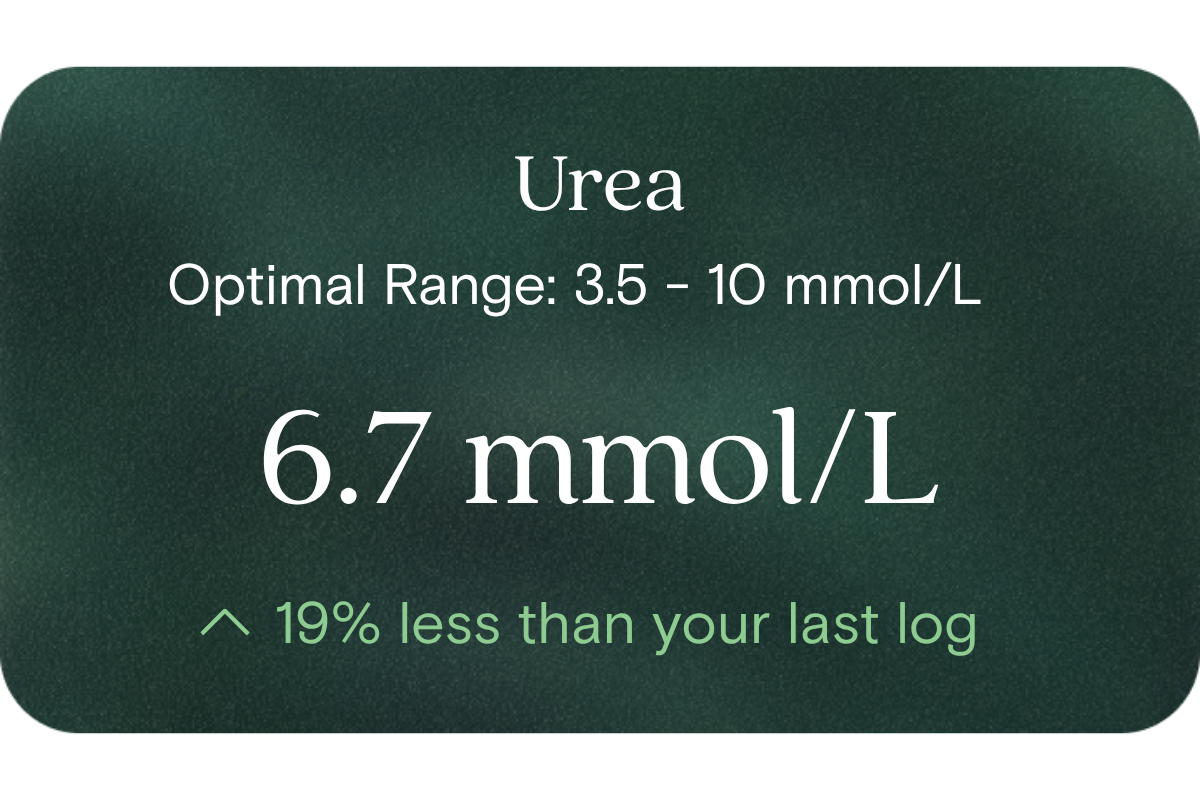What is Urea (blood urea nitrogen, BUN)?
Urea is the major stable end-product of protein metabolism in the body. After amino acids are de-aminated in the liver, the ammonia produced is incorporated into urea via the urea cycle. Urea then enters the bloodstream and is filtered and excreted by the kidneys. The term “blood urea nitrogen (BUN)” comes from older measurement methods, but in Australia you’ll often see the result reported as urea in mmol/L.
Why does it matter for long-term health and wellbeing?
Because urea reflects the balance between protein breakdown, liver processing and kidney excretion, it serves as a valuable indicator of metabolic workload, hydration status and the health of your clearance systems. For long-term health and performance you want these systems working together efficiently. If urea levels are consistently elevated (or conversely very low), it suggests there’s an imbalance or extra stress on your protein metabolism or clearance pathways — giving you an early signal to adjust nutrition, hydration, or lifestyle rather than waiting for symptoms to emerge.
What’s an optimal level of Urea (BUN)?
- Reference (lab) range in Australian practice: ~2.5 to 7.5 mmol/L (note many labs list ~3.0 to 10.0 mmol/L)
- Vively’s suggested “optimal” target range (for proactive health, not treatment): ~3.5 mmol/L up to ~7.5 mmol/L.
(Values below ~3.5 mmol/L may suggest under-production or low protein intake; values above ~7.5 mmol/L warrant a closer look at lifestyle factors.) Please note that “optimal” ranges are a guideline for lifestyle insight, not a diagnostic threshold.
What influences Urea (BUN) levels?
- Protein intake and breakdown: Higher dietary protein or increased tissue turnover (e.g., from intense training) raises ammonia production and thus urea formation.
- Hydration status: Dehydration reduces the volume of fluid available for clearance, which can increase urea concentration.
- Liver processing capacity: The liver’s ability to convert ammonia into urea matters — if this is less efficient, urea levels may be altered.
- Kidney clearance: Effective filtration and excretion by the kidneys lowers urea — if clearance is reduced, urea accumulates.
- Other lifestyle factors: High-catabolic states (e.g., heavy training, trauma) can raise urea production; conversely low protein diet or over-hydration could reduce it.
What does it mean if Urea (BUN) is outside the optimal range?
- If your urea is above the optimal window (e.g., > ~7.5 mmol/L): this suggests that your body is processing higher than ideal levels of protein/ammonia, or that clearance (via kidneys or hydration) is under stress. It signals you might benefit from adjusting your hydration, evaluating your protein load, or monitoring your kidney/liver capacity as part of performance-oriented support.
- If your urea is below the optimal window (e.g., < ~3.5 mmol/L): this may mean you have a lower than expected protein turnover or intake, or your liver might be under-processing ammonia. For someone focused on muscle mass, recovery or metabolic efficiency, this can be a cue to review nutrition and recovery parameters.
How can I support healthy Urea (BUN) levels?
- Maintain balanced protein intake: enough to support muscle repair and metabolic needs — but avoid excessive protein loads which increase urea production.
- Ensure good hydration: adequate fluid volume supports the kidneys in clearing urea efficiently.
- Support liver and kidney-friendly habits: moderate alcohol, maintain healthy body weight, manage training load and recovery to avoid excessive catabolism.
- Monitor over time: test periodically to observe trends (rather than just a single value) and correlate with your nutrition, hydration, training and recovery habits. This empowers you to fine-tune your lifestyle for sustained energy, metabolic clarity and wellbeing.
This information is provided for general health and wellness purposes only and does not replace medical advice.
References
- “Tests – Urea (blood and urine)”. Pathology Tests Explained (Australia).
- “Urea”. Royal College of Pathologists of Australasia Manual – Pathology Tests.
- Higgins, C. “Urea and the clinical value of measuring blood urea concentration.” Acute Care Testing.
- Hosten, A. O. “BUN and Creatinine.” Clinical Methods. NCBI Bookshelf.




















.png)
